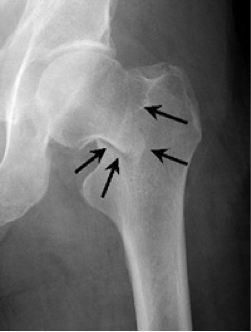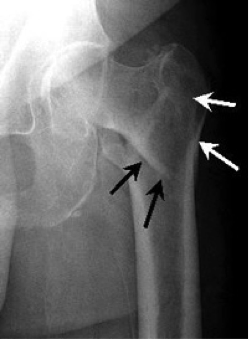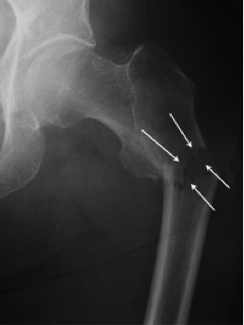What Is A Hip Fracture?
A hip fracture is a break in the upper part of the femur (thigh) bone. The extent of the break depends on the forces that are involved. The type of surgery used to treat a hip fracture is primarily based on the bones and soft tissues affected and on the location of the fracture.
Causes
Hip fractures most commonly occur from a fall or from a direct blow to the side of the hip. Some medical conditions such as osteoporosis, cancer, or stress injuries can weaken the bone and make the hip more susceptible to breaking. In severe cases, it is possible for the hip to break with the patient merely standing on the leg and twisting.
Symptoms
The patient with a hip fracture will have pain over the outer upper thigh or in the groin. There will be significant discomfort with any attempt to move the hip.
If the bone has been weakened by disease (such as a stress injury or cancer), the patient may notice aching in the groin or thigh area for a period of time before the break. If the bone is completely broken, the leg may appear to be shorter than the non-injured leg. The patient will often hold the injured leg in a still position with the foot and knee turned outward (external rotation).

Radiological Assessment
The diagnosis of a hip fracture is generally made by an X-ray of the hip and femur.
Hip fractures occur at the upper end of the thigh bone (femur).
In some cases, if the patient falls and complains of hip pain, an incomplete fracture may not be seen on a regular X-ray. In that case, magnetic resonance imaging (MRI) may be recommended. The MRI scan is a useful diagnostic test in equivocal cases.
An MRI may identify a hip fracture otherwise missed on plain X-ray.
If the patient is unable to have an MRI scan because of an associated medical condition, computed tomography (CT) may be obtained instead. Computed tomography, however, is not as sensitive as MRI for seeing hidden hip fractures.
Types Of Fractures
In general, there are three different types of hip fractures. The type of fracture depends on what area of the upper femur is involved.
FEMORAL NECK FRACTURE
Neck of femur fractures (NOF) are common injuries sustained by older patients who are both more likely to have unsteadiness of gait and reduced bone mineral density, predisposing to fracture. Elderly osteoporotic women are at greatest risk.
EPIDEMIOLOGY
It is anticipated that the total number of hip fractures will exceed 6 million people in 2014. In patients aged between 65 and 99, femoral neck and intertrochanteric fractures occur with approximately similar frequency.
MECHANISM
Most commonly:
- Falls in the elderly
- Significant trauma (e.g. motor vehicle collisions) in younger patients
- Stress fractures (less common)
TREATMENT AND PROGNOSIS
The treatment options include non-operative management, internal fixation or prosthetic replacement.
The high morbidity and mortality associated with hip and pelvic fractures after trauma has been well documented. Prognosis is varied, but is complicated by advanced age, as hip fractures increase the risk of death and major morbidity in the elderly.
FEMUR SHAFT FRACTURES (BROKEN THIGHBONE)
Your thighbone (femur) is the longest and strongest bone in your body. Because the femur is so strong, it usually takes a lot of force to break it. Car crashes, for example, are the number one cause of femur fractures.
The long, straight part of the femur is called the femoral shaft. When there is a break anywhere along this length of bone, it is called a femoral shaft fracture.
CAUSE
Femoral shaft fractures in young people are frequently due to some type of high-energy collision. The most common cause of femoral shaft fracture is a motor vehicle or motorcycle crash. Being hit by a car as a pedestrian is another common cause, as are falls from heights and gunshot wounds.
A lower-force incident, such as a fall from standing, may cause a femoral shaft fracture in an older individual.
SYMPTOMS
A femoral shaft fracture usually causes immediate, severe pain. You will not be able to put weight on the injured leg, and it may look deformed — shorter than the other leg and no longer straight.
RECOVERY
Most femoral shaft fractures take 4 to 6 months to completely heal. Some take even longer, especially if the fracture was open or broken into several pieces.
Because you will most likely lose muscle strength in the injured area, exercises during the healing process are important. Physical therapy will help to restore you normal muscle strength, joint motion, and flexibility.
A physical therapist will most likely begin teaching you specific exercises while you are still in the hospital. The therapist will also help you learn how to use crutches or a walker.

Intra-Capsular Fracture
This fracture occurs at the level of the “neck” of the bone and may have loss of blood supply to the bone.

Inter-Trochanteric Fracture
This fracture occurs between the neck of the femur and a lower bony prominence called the lesser trochanter. The lesser trochanter is an attachment point for one of the major muscles of the hip.

Sub-Trochanteric Fracture
This occurs even further down the bone and may be broken into several pieces.
In more complicated cases, the amount of breakage of the bone can involve more than one of these zones. This is taken into consideration when surgical repair is considered
Treatment
Most surgeons agree that patients do better if they are operated on fairly quickly.
Certain fractures that have not moved (“displaced”) may not require surgery. Because there is a risk that they may move later on, they are often fixed.
Certain types of fractures may be considered stable enough to be managed with non-surgical treatment. Because there is some risk that these “stable” fractures may instead prove unstable and displace (change position), Dr Parminder J Singh will need to follow you up in his rooms with periodic X-rays of the area until the fracture has united satisfactorily.


After Surgery
Patients may be discharged from the hospital to their home or find that a stay in a rehabilitation facility is necessary to assist them in regaining their ability to walk.
REHABILITATION
The amount of weight that is allowed to be placed on the injured leg will be determined by the surgeon and is generally a function of the type of fracture and repair (fixation).
The physical therapist will work with the patient to help regain strength and the ability to walk. This process may take up to three months.
MEDICAL CARE
Most patients will be placed on medicine to thin their blood to reduce the chances of developing blood clots for up to 6 weeks.
FOLLOW UP CARE
During the appointments that take place after surgery, Dr Parminder J Singh will want to check the wound, remove sutures, follow the healing process using X-rays, and prescribe additional physical therapy, if necessary.
Following hip fracture surgery, most patients will regain the majority of their mobility and independence.
Consulting Locations
Richmond VIC 3121
Book a consultation on:
(03) 9428 4128
343-357 Blackburn Rd,
Mt. Waverley VIC 3149
Book a consultation on:
(03) 9428 4128
Book Online at Waverley Private Hospital
Blackburn VIC 3130
Book a consultation on:
(03) 9428 4128
Book Online at Forest Hill
Gisborne VIC 3437
Book a consultation on:
(03) 9428 4128
Book Online at Gisborne
262 Main St,
Mornington VIC 3931
Book a consultation on:
(03) 9428 4128
Book Online at Mornington
108 Bridport Street,
Albert Park VIC 3206
Book a consultation on:
(03) 9428 4128
Book Online at Albert Park
240 Hoppers Lane,
Werribee VIC 3030
Book a consultation on:
(03) 9428 4128
Make an appointment with our Melbourne orthopaedic surgeons
If you are a patient suffering from a knee or hip issue, you can get a referral and make an appointment with a surgeon at PJS Orthopaedics at a time and location that suits you.
Whether your knee or hip injury is a result of playing sport, has come about because of trauma injury, or is simply due to wear and tear, our Melbourne surgeons have the experience and expertise to find a surgery solution that is right for you.





